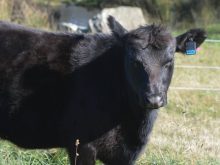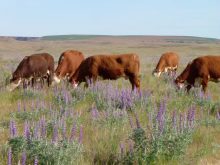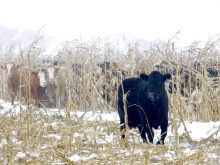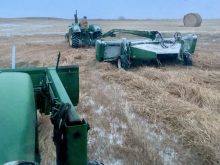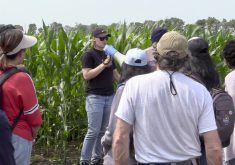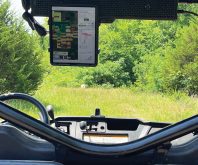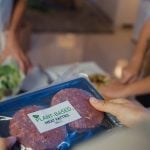Looking back at a Grainews from last winter, I read a line I wrote saying that the options for cattle producers to take advantage of carbon markets are currently limited. This is still largely true, but a lot sure has changed in the past year, which has seen the release of new programs geared towards rewarding graziers for carbon sequestration and/or avoided conversion of fragile grasslands.
One new program out of the gate this year is the Grazing Forward program from ALUS Canada. This program is funded by contributions of $1.8 million from Cargill and A&W Canada and it’s targeted to cover 6,000 acres across 20 different ALUS Communities. This represents a major expansion to the ALUS’New Acre Project and is the first project of its kind through its network of farmer-delivered ecosystem goods and services.
Read Also

Harvest wraps up and fall work begins
At the Eppich famly ranch in western Saskatchewan, the fall harvest was successful with few breakdowns, cows and calves have been sorted and a new tractor has arrived
As a bit of background, ALUS, (the acronym for Alternative Land Use Services), is a national community-developed and farmer-delivered program that produces, enhances and maintains ecosystem services on agricultural lands. Projects such as wetland restoration and enhancement, riparian buffers, shelterbelts, afforestation and native prairie grass restoration provide cleaner water and air, habitat, carbon sequestration and climate resiliency.
The Grazing Forward program is designed to deliver carbon sequestration through support of local Adaptive Multi-Paddock (AMP) grazing projects, but more on that later).
A distinct feature of the Grazing Forward program is that the payments are for local management practices that sequester carbon, rather than specific carbon offsets. The adoption of these management practices through the program is targeted to sequester approximately 12,578 metric tons (MT) of carbon each year, roughly the equivalent of 51 million kilometres of driving for a passenger vehicle.
Good news story
This is a good news story for producers for a couple of very important reasons. First, it recognizes that producers can and do deliver environmental goods and services, and second it recognizes and encourages producers as part of the solution. By providing an on-the-ground example of carbon sequestration through a farmer-delivered solution, it provides an important public example of what can be done.
Another project making significant advancements over the past year has been the Canadian Forage and Grasslands Association (CFGA) Avoided Conversion of Grasslands Carbon Offset Protocol.
This is slightly different than the ALUS program, as it provides a framework for selling carbon credits into the marketplace. This may play a significant role in the ALUS approach moving forward.
Carbon protocols are important as they create the “rules” for trading in the commercial carbon market. Without an accepted protocol, it is not possible to market carbon credits in established markets or on a large scale. For example, because protocols exist historically for cropping systems, a producer could break up native prairie, releasing stored carbon, and then sell carbon credits by adhering to the no-till protocols.
The development of non-conversion protocols means that a producer would have access to market carbon from those acres without breaking them up first. There are some pilot projects underway using this protocol, so stay tuned.
There are several other projects in the works across the country and it is an exciting time as these new markets are opening up and as those who are at the leading edge are comparing notes and developing a better overall system.
How the programs work
First a bit of biology — The way a forage plant works at the most basic level is that it collects solar energy and uses it to bind carbon dioxide from the air with water to produce carbohydrates (sugars). These sugars are then used to produce roots/shoots, feed underground life (bugs) and above-ground life (cows). The shoots of the plant are in essence a solar pump to drive carbon underground where a portion of it is stored (sequestered) for long periods.
When we till a grassland, this carbon is exposed to air, where it is oxygenated and becomes the greenhouse gas we know as carbon dioxide.
People, companies or governments that emit carbon and have commitments to be carbon neutral or to hit emissions targets, have options including reducing their emissions or buying carbon sequestration to “offset” their emissions.
For example, if Company A is committed to 50MT of carbon emissions and emits 100MT they can either find a way to cut their emissions by 50MT or they can purchase 50MT of sequestration to offset their carbon footprint.
The development of protocols allows quantification and thus valuation of the carbon that is/can be sequestered on an area of land with specific management applied. Measurement of carbon can be expensive and difficult on a field scale, so having proven and accepted protocols allows the sale of carbon without incurring all of the costs of measuring carbon on every square foot of a farm or ranch.
Where AMP comes in
This is where AMP (Adaptive Multi-Paddock) grazing through the ALUS Grazing Forward program fits into the discussion as a management technique that helps to store carbon underground.
There has been significant research on AMP grazing systems in Western Canada over the last several years and the results generally show that adaptive grazing practices can sequester significant amounts of carbon.
AMP grazing could simply be described as dividing pastures into smaller paddocks and moving cattle through the paddocks to allow regrowth/recovery of plants in previously grazed paddocks. Some people may refer to it by different names such as ‘rotational grazing’ or ‘management-intensive grazing,’ but the key idea is that the animal movement is governed by the plant growth and recovery (that is the adaptive part), rather than a strict calendar.
AMP grazing does not mean that you have to move cattle every day or every four hours, but it does mean that animals need to be moved to allow plants to recover. There is a lot of good information from Canada on AMP grazing and impacts at grad.biology.ualberta.ca/boyce/aggp-grazing-project/.
This stems from research conducted by Mark Boyce, Alberta Conservation Association chair in Fisheries and Wildlife at the Department of Biological Sciences, University of Alberta. During the past five years, Boyce and a team of U of A researchers have evaluated possible benefits of adaptive multi-paddock grazing. Intense short-period grazing is followed by a long rest, allowing vegetation growth. Paired ranches were compared across Canada’s Great Plains, showing that AMP benefits water infiltration, deepens topsoil profile, increases litter and enhances livestock yield.
One of the key takeaways from the work done by Boyce and his team is simply the sheer scale of the number of people, time and effort involved in testing and identifying the management impacts of different management techniques.
As the carbon market for grasslands evolves, likely other practices will also receive approval for carbon markets. Practices such as deferred grazing or winter grazing of perennials may allow for carbon to be sequestered during the growing season and could potentially qualify under future protocols.
Whether the carbon market confuses or angers you, or if you think it is an opportunity, I think it is fair to say that it is not going away anytime soon. As a producer, obtaining a working knowledge of carbon markets is important as we will be impacted either positively or negatively (or both) by having a price on carbon. Looking forward, carbon may represent an increasingly valuable product to store on your farm or ranch.
For more information on ALUS visit www.alus.ca the Canadian Forage and Grasslands Association canadianfga.ca.



